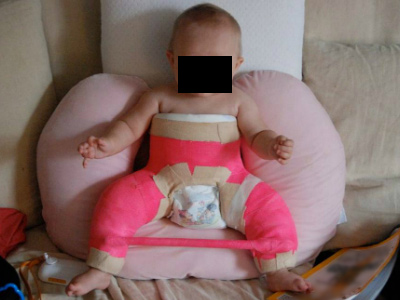Tips for Caring for Your Child in a Spica Cast
As if having an infant or young child with an orthopedic condition requiring treatment isn’t enough, now you are told your child will need a spica cast. While it seems insurmountable to care for a child in a spica cast, many parents have walked this road before and have succeeded. You will too!
What is a spica cast?
A spica cast (also called a hip spica cast or body cast) is an orthopedic cast that stabilizes a femur fracture or a hip joint after surgery for hip dysplasia in infants and young children. The cast, which is made of fiberglass with a soft lining inside, immobilizes the thigh, hip, and pelvis. The cast covers the chest, one or both thighs, and may extend below the knees and/or ankles. Special care is needed when changing diapers, cleaning, and transporting children who have a spica cast.

When is a spica cast required?
A spica cast is needed to treat femur fractures and hip dysplasia in young children. A spica cast is the standard of care for management of femur fractures for children younger than five years old weighing less than 50 pounds. The location and pattern of the femur fracture determine how much of the injured lower extremity will be secured in the spica cast. Often, both legs may be casted. The spica cast is also utilized to keep the hip joint stable to facilitate healing of the bones and soft tissue structures in infants and young children treated for developmental dysplasia of the hip.
How do I care for a spica cast?
Over time, the spica cast will become a little dingy, but it is best to keep it as clean and dry as possible. You will need to sponge-bathe your child. A waterproof liner that is adjacent to the body helps with bowel and bladder hygiene, but the cast is not waterproof. If the cast gets wet, it is best to call your doctor because the moisture will quickly irritate the skin beneath the cast. If the cast is a little damp from sponge bathing or cleaning the groin area, it is fine to use a hair dryer on a cool setting to dry the cast.
Spica cast care tips
- Children in spica casts need hugs too! First and foremost, remember that your child will need your love and gentleness more than he or she needs a spotless cast.
- Be prepared. Here is a list of helpful items for your home:
- A special car seat, as your child will probably not fit in the regular car seat in the spica cast.
- A reclining wheelchair, special stroller, or wagon.
- diapers in two sizes – one to fit inside and one to fit outside the cast.
- Sanitary napkins to fit inside the inner diaper for extra absorbency at night.
- A bedpan or urinal for older children.
- Moleskin for rough edges of the cast and to keep the waterproof liner in place.
- A hair dryer with a cool setting.
- A flashlight to use to see into the cast to check the skin for sore areas.
- Check your child’s skin frequently, about four times a day.
- Change your child’s position to prevent pressure sores from being in one position for too long.
- Check the toes for swelling, movement, and discoloration.
- Use a flashlight to check the skin under the cast for sores or blisters.
- You can bathe your child in a spica cast but it must be a sponge bath.
- Use a lightly damp wash cloth to clean the skin under the cast.
- Do not use powders or lotions as they can irritate the skin.
- Gravity is your friend. Keep the chest above the hips to help direct urine into the diaper and to keep it from pooling in the cast.
- A change of scenery is good for everyone. Remember to keep your child restrained in any vehicle, highchair, or stroller/wheelchair.
- Due to inactivity, constipation can become a problem. Make sure to include fruits and vegetables in your child’s diet.
- Dresses and sweatpants work great. Underpants can be altered to have a Velcro closure for older children.
- It is best to lift your child by supporting the back and both legs, rather than under the arms.
- This too shall pass. Having a child in a spica cast is challenging. You are not alone. Make sure to call your doctor’s office with any questions or concerns.
Posted: 6/29/2023
Authors
Associate Attending Orthopedic Surgeon, Hospital for Special Surgery
Associate Professor of Orthopedic Surgery, Weill Cornell Medical College

